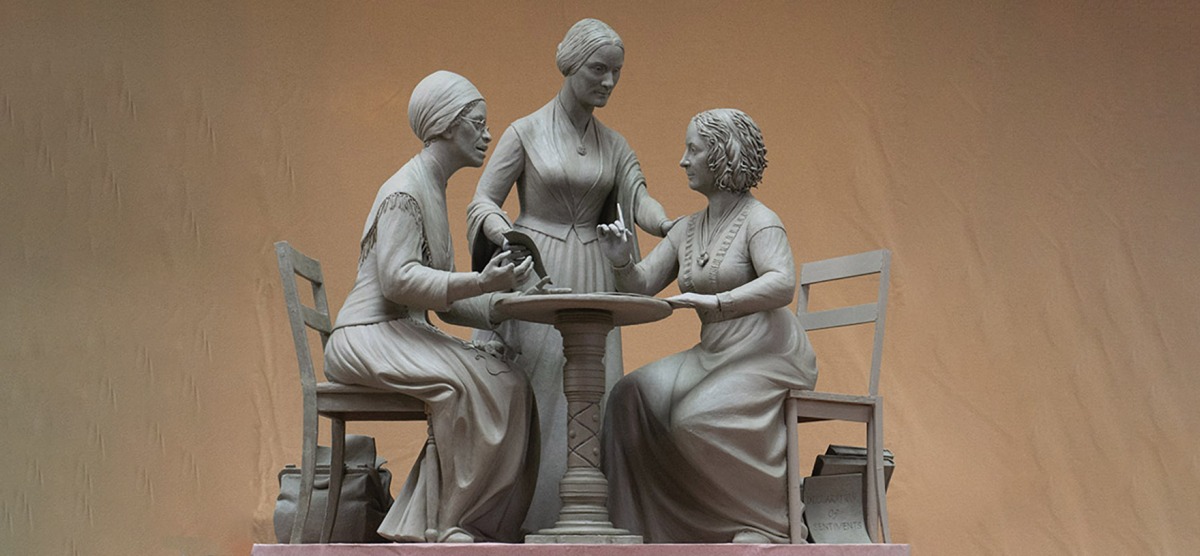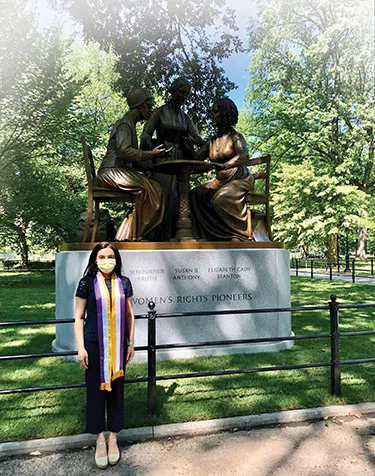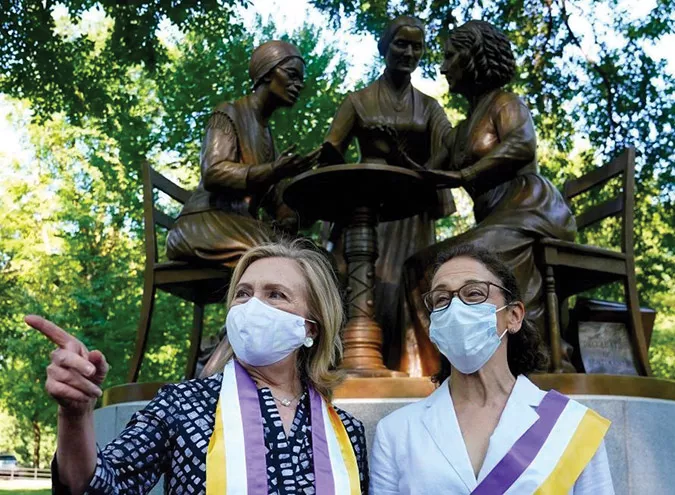
In Their Honor
On the 100th anniversary of the 19th Amendment, Monumental Women unveiled a statue honoring three suffragists.
On August 26, the 100th anniversary of the ratification of the 19th Amendment, three pioneers of the suffrage movement joined the scores of prominent men whose statues grace New York’s Central Park. With the unveiling, the trio—Sojourner Truth, Susan B. Anthony, and Elizabeth Cady Stanton—became the only historical women so honored. (All the other female figures represented in the park’s statuary are fictional.)
The statue was commissioned by the nonprofit Monumental Women. Its mission, says Namita Luthra ’91, is threefold: “to ‘break the bronze ceiling’ in Central Park, challenge other municipalities to honor women and people of color in their public spaces, and create a women’s history education campaign.”
Luthra, who sits on the Monumental Women board, continues, “Every year— except during a global health pandemic—42 million people visit Central Park, and they deserve to see tributes to real women, the ones who gave their lives to expanding our definition of ‘We the People.’ The Women’s Rights Pioneers Monument honoring Sojourner Truth, Susan B. Anthony, and Elizabeth Cady Stanton is a fitting start.”
Luthra first learned about the monument in 2016 from newspaper reports about the fund- and awareness-raising efforts of Girl Scouts. “My daughter is a Girl Scout, and I presented the idea to her troop—a group of wonderful, intelligent fourth-graders, many of whom had grown up playing in Central Park. I’ll never forget the moment I asked them if they’d ever noticed that the park had no statues of women. ‘Wait, not a single one?’ they asked incredulously.”
Inspired, the Scouts brainstormed ideas about how to contribute. Turning to that classic Girl Scout fundraiser, they decided to donate their cookie sale money to the project. That year, they raised $2,000, double their original goal, and presented all of it to Monumental Women.
The Scouts weren’t the only ones on the job. Monumental Women raised more than $1.5 million dollars—“none of which,” Luthra notes, “could have happened without the early and vital support of New York Life.” Unwavering support also came from the Manhattan Borough President Gale Brewer, Councilwoman Helen Rosenthal, and more than 1,000 individual donations.
Sculptors from around the country submitted proposals to a design competition. From more than 90 submissions, a nine-member jury chose Meredith Bergmann’s design. The original design featured Anthony, Stanton, and a long scroll etched with quotations of diverse suffragists all leading to a ballot box.
The City’s Public Design Commission unanimously approved the monument but nixed the scroll and ballot box. “We knew we had to include the diversity of women in a different way,” Luthra explains. It was decided that another New Yorker, abolitionist and women’s rights advocate, Sojourner Truth, would take her rightful place at the table.
In September 2019, the amended design was presented to the Commission. “I, along with other Monumental Women board members, and Ms. Bergmann, testified at City Hall in favor of the new design,” says Luthra. A month later, it was approved.
Located on Literary Walk—a prominent site in Central Park— the monument stands 14 feet tall and weighs around 73,000 pounds (36 tons). “Last fall when I saw the work in progress in the sculptor’s Connecticut studio,” Luthra says, “I was awed by the size but even more moved by the small details: Truth’s hand and Anthony’s alligator-skin bag bursting with papers including a Petition for Universal Suffrage.”
Hillary Rodham Clinton and Meredith Bergmann at the unveiling.
The August 26 unveiling was a historic day, celebrating three women’s rights pioneers: Truth, Anthony, and Stanton—all New Yorkers. As Luthra explains, “They sit, working around a table, each one representing a different arm of activism: speaking, writing, and as Anthony put it, ‘agitating.’ Isn’t that the way so much of women’s work gets done—hatching ideas, reimagining the world, and then going out to make change?”
And the monument was both seen and heard as six of the country’s most prominent actors gave voice to the three suffragists: Viola Davis speaking as Truth, Meryl Streep as Stanton, and Jane Alexander as Anthony. For the Spanish-language version, Zoe Saldana, Rita Moreno, and America Ferrera did the honors.
Speaking of the moment of the unveiling, Luthra says, “We are asking everyone watching, no matter where they are in the world, to reimagine their public spaces in their towns and ask if they honor the important women who paved the way for generations to come?”
And, Luthra adds, “We were delighted that Secretary Hillary Rodham Clinton attended the unveiling in person. She said, ‘It seems especially appropriate that today on Women’s Equality Day, we are unveiling a new statue in Central Park for the first time in over six decades. The first statue of real, non-fictional women … the first statue of an African- American … and significantly, a statue that depicts three great Americans working together. … So, our charge now, as we stand in the great river of history, is to take the stories of the women in this statue and carry them forward into our schools, into the media, onto social media, and into our lives. ... There’s nothing more important, however, to honor the women portrayed in this statue, than to vote.’”
The monument, Luthra explains, was always the start, and never the end, of the work. “Helping municipalities across the country reimagine their public spaces and pay tribute to the women and people of color who helped make them was always a central aim. Launching a women’s rights education campaign to make history come alive has also begun in earnest.”
For Luthra, Monumental Women—the Central Park statue, the effort to seed similar projects nationwide, and the educational component—represents a long-standing commitment to advancing women’s rights. “My time as a litigator at the ACLU Women’s Rights Project, founded by Ruth Bader Ginsburg in 1972, was among the most rewarding of my career,” she says. “Now, my work with Monumental Women pays homage to the past but keeps me laser-focused on the work toward full equality that lies ahead.”
And as far back as Bryn Mawr, Luthra was on the job: “I remember researching in Canaday Library and writing a paper about the interconnectedness of the abolition and suffrage movements," she explains. “Life has come full circle from that first research paper until now.”
Asked how she would persuade a skeptic of the projects’ significance, Luthra is eloquent: “When you excavate women’s history and learn the faces and voices of the fearless, strategic, and persistent women who came before and all they had to overcome, it feels like there’s no limit to what you can achieve. There’s an unbroken link that ties their generation to ours and ours to the generations of girls and women still to come.”
Published on: 11/25/2020

